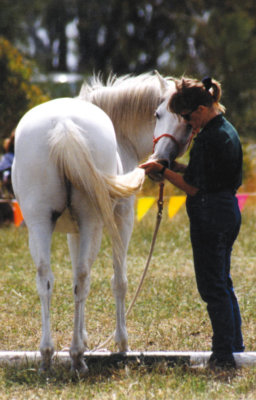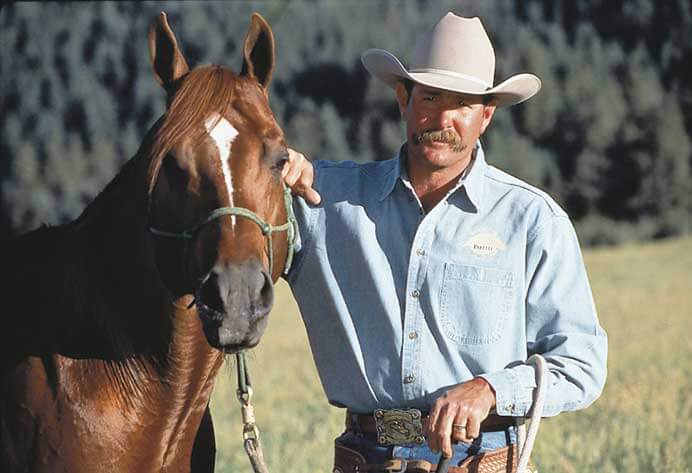Game #2 in the series of the Seven Games with Pat Parelli
Horses naturally push into steady pressure. Moving against it or barging through it is how they escape predators in the wild. Mother Nature tells them to break loose of a predator’s hold or crash through an obstacle that’s in the way of escape. So, pushing into steady pressure is part of their programming for survival.
In the process of developing communication with a horse, yielding from physical pressure is a major factor. Think of it – the halter, bit, reins, your leg and seat all involve steady physical pressure.
The better your horse yields from the light and steady feel of your fingertips, the easier he will be to handle – on the ground and when ridden. Every time you make light contact with the halter, lead rope, bit, your leg, seat or hands, your horse should respond respectfully and willingly. Moving your horse around should feel like pushing a toy boat around in the bathtub – no resistance.
Types of pressure
There are two basic ways to ask a horse to do something:
- Steady, physical pressure
- Rhythmic, non-physical pressure
A horse will move away from rhythmic pressure more easily than from steady pressure. His flighty nature makes him more inclined to move away from things like swinging ropes or waving hands. But he will find it easier to lean into your leg, your hands or the halter.
That’s why the Porcupine Game can be somewhat of a challenge. In fact, many people avoid it or play very little of this game when they are learning the Seven Games and instead use mostly rhythmic pressure (Driving Game, #3) to yield their horse. They may think their horses are yielding really well but they’re not touching them. When they do ask their horse to move from light, steady pressure they find their horses push back or barely respond.
Be a porcupine
Real porcupines teach any animal to yield and in a hurry! They give some early, subtle warnings about what they intend to do, then if the warnings are not heeded, the porcupine steadily and progressively increases the pressure until he finally releases quills.
To be as effective as a real porcupine, give plenty of warning then follow through. There are distinct stages that you must incorporate in order to be assertive without becoming aggressive: intention, steady pressure, and approach and retreat.
Intention
Your intention shows up as a determined look. For example, if you had to move a sofa, you’d get a determined look on your face and muster up the right amount of energy, then you would push or lift. You wouldn’t have your television-watching face on with relaxed body energy.
You’re not going to give your horse an almighty push, but I do want you to understand this important concept. Your look, your life and your forward body language help you clearly convey your intention, “Move away from my oncoming pressure.” If you don’t differentiate your look from a “Friendly” look (game #1) to a “Porcupine” look you will confuse your horse. Lots of people don’t differentiate their body language and then wonder why their horse can’t understand them. You need to be clear.
Steady Pressure
This means gentle pressure is applied smoothly and steadily, not intermittently. When asking a living, thinking, feeling being to move overusing your hands, you wouldn’t give him a big shove like he was a sofa! You’d start with a soft suggestion of pressure and then gradually build it until you got a response. The question is how soft is soft … and how strong is strong?
Soft pressure means starting with the lightest possible touch. “Strong” pressure is determined by the horse, it means being effective enough to cause him to move. This could be 4 ounces of steady pressure or 4 pounds.
Approach and retreat
As you ask your horse to yield, the pressure starts with a determined look and a soft touch then becomes progressively and smoothly more insistent, making it increasingly uncomfortable for the horse if he doesn’t move. The INSTANT the horse responds by moving away, or even tries to respond by shifting his weight, immediately release all the pressure! It’s not the pressure that teaches. It’s the release from pressure that tells the horse he did the right thing.
 To sensitize a horse, you need to be ready to release as soon as he tries to do what you ask. If you keep pressing after the horse has responded you will de-sensitize him and he’ll become dull. He will lose incentive to do what you want, and it will take more and more pressure to get him to respond at all. Comfort is a major motivational factor for a horse, and you need to show him how he can attain comfort by yielding to pressure.
To sensitize a horse, you need to be ready to release as soon as he tries to do what you ask. If you keep pressing after the horse has responded you will de-sensitize him and he’ll become dull. He will lose incentive to do what you want, and it will take more and more pressure to get him to respond at all. Comfort is a major motivational factor for a horse, and you need to show him how he can attain comfort by yielding to pressure.
By coming on too strong without enough feel for the horse or not following through to be effective, the horse can become dull and disrespectful.
Watch horses flicking flies from their skin to see how incredibly sensitive they are. Once your horse understands what you are asking for, he’ll be glad to respond to the lightest touch every time you offer it. On the other end of the scale, you need to be effective. If your horse can stand there while you are pushing for all you’re worth, you are not being effective!
Next part we’ll talk about how this game helps develop a light and responsive horse, and about the opposition reflex.
Want to know more? You will find more detailed information on the Porcupine Game, and any of the Seven Games in the Partnership pack, Part 1 of Pat Parelli’s Savvy System. Call Parelli Natural Horse•Man•Ship at 1-800-642-3335 or visit www.parelli.com for a free brochure. Images provided by Parelli.
Reprinted from the March 2003 Issue

Pat Parelli is an American horse trainer who practices natural horsemanship and founded the Parelli Natural Horsemanship program.






